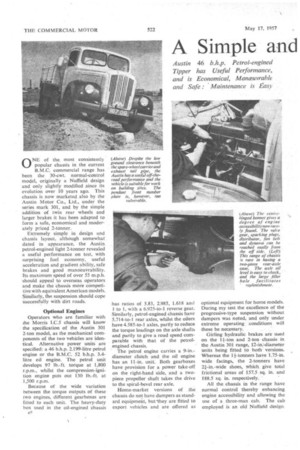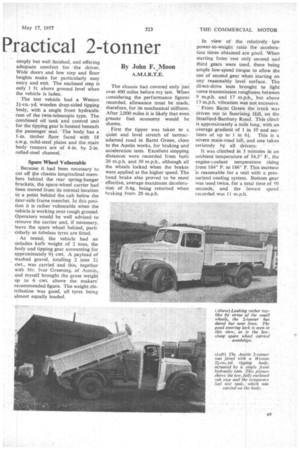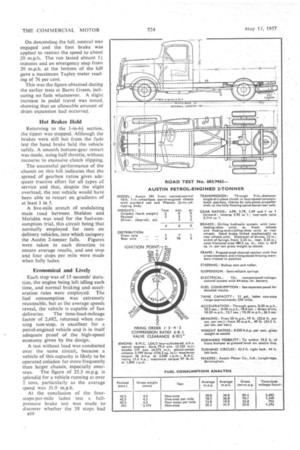A Simple and
Page 42

Page 43

Page 44

Page 45

If you've noticed an error in this article please click here to report it so we can fix it.
Practical 2-tonner
By John F. Moon
A.M.I.R.T.E. Austin 46 b.h.p. Petrol-engined Tipper has Useful Performance, and is Economical, Manceuvrabk and Safe : Maintenance is Easy ONE of the, most consistently popular chassis in the current B.M.C. commercial range has been the 30-cwt. normal-control model, originally a Nuffield design and only slightly modified since its evolution over 10 years ago. This chassis is now marketed also by the Austin Motor Co., Ltd., under the series mark 301, and by the simple addition of twin rear wheels and larger brakes it has been adapted to form a safe, economical and moderately priced 2-tonner.
Extremely simple in design and chassis layout, although somewhat dated in appearance, the Austin petrol-engined light 2-tonner revealed a useful performance on test, with surprising fuel economy, useful acceleration and gradient ability, safe brakes and good manoeuvrability. Its maximum speed of over 55 m.p.h. should appeal to overseas operators and make the chassis more competitive with equivalent American models. Similarly, the suspension should cope successfully with dirt roads.
Optional Engines
Operators who are familiar with the Morris LC.5 chassis will know the specification of the Austin 301 2-ton model, as the mechanical components of the two vehicles are identical. Alternative power units are specified: a 46 b.h.p. 2.199-litre petrol engine or the E.M.C. 52 b.h.p. 3.4litre oil engine. The petrol unit develops 97 lb.-ft. torque at 1,800 r.p.m., whilst the compression-ignition engine puts out 130 I h.-ft. at 1,500 r.p.m.
Because of the wide variation between the torque outputs of these two engines, different gearboxes are fitted to each unit. The heavy-duty box used in the oil-engined chassis us has ratios of 5.83, 2.985, 1.618 and 1 to 1, with a 6.925-to-1 reverse gear. Similarly, petrol-engined chassis have 5.714-to-I rear axles, whilst the oilers have 4.585-to-1 axles, partly to reduce the torque loadings on the axle shafts and partly to give a road speed comparable with that of the petrolengined chassis.
The petrol engine carries a 9-in.diameter dutch and the oil engine has an 11-in. unit Both gearboxes have provision for a power take-off on the right-hand side, and a twopiece propeller shaft takes the drive to the spiral-bevel rear axle.
Home-market versions of the chassis do not have dampers as standard equipment, but 'they are fitted to export vehicles and are offered as optional equipment for home models. During my test the excellence of the progressive-type suspension without dampers was noted, and only under extreme operating conditions will these be necessary.
Girling hydraulic brakes are used on the 11-ton and 2-ton chassis in the Austin 301 range, 12-in.-diameter units being fitted to both versions. Whereas the 11-tonners have 1.75-in. wide facings, the 2-tonners have 21-in.-wide shoes, which give total frictional areas of 157.5 sq. in. and 188.5 sq. in. respectively.
All the chassis in the range have normal control thereby enhancing engine accessibility and allowing the use of a three-man cab. The cab employed is an old Nuffield design. simply but well finished, and offering adequate comfort for ' the driver. Wide doors and low step and floor heights make for particularly easy entry and exit. The enclosed step is only 1 ft. above ground level when the vehicle is laden.
The test vehicle had a Weston 21-cu.-yd. wooden drop-sided tipping body, with a single front hydraulic ram of the twin-telescopic type. The combined oil tank and control unit for the tipping gear is housed beneath the passenger seat. The body has a 1-in, timber floor faced with 18 s.w.g. mild-steel plates and the main body runners are of 4-in. by 2-in. rolled-steel channel.
Spare Wheel Vulnerable Because it had been necessary to cut off tthe chassis longitudinal members behind the rear spring-hanger brackets, the spare-wheel carrier had been moved from its normal-location to a point behind the cab below the near-side frame member. In this position it is rather vulnerable when the vehicle, is working over rough ground. Operators would be well advised to remove the carrier and, if necessary, leave the spare wheel behind, particularly as tubeless tyres are fitted.
As tested, the vehicle had an unladen kerb weight of 2 tons, the body and tipping gear accounting for approximately 91 cwt. A payload of washed gravel, totalling 2 tons 24 cwt., was carried and this, together with Mr. Ivor Greening. of Austin, and myself brought the gross weight up to 6 cwt. above the makers' recommended figure. The weight distribution was good, all tyres being almost equally loaded. The chassis had covered only just over 400 miles before my test. When considering the performance figures recorded, allowance must be made, therefore, for its mechanical stiffness. After 2,000 miles it is likely that even greater fuel economy would be. shown.
First the tipper was taken to a quiet and level stretch of tarmv.adamed road in Bamt Green, close to the Austin works, for braking and acceleration tests. Excellent stopping distances were recorded from both 20 m.p.h. and 30 m.p.h., although all the wheels locked when the brakes were applied at the higher speed. The hand brake also proved to be most effective, average maximum deceleration of 0.4g. being returned when braking from 20 m.p.h. In view ofthe relatively low power-to-weight ratio the acceleration times obtained are good. When starting from rest only second and third gears were used, there being ample low-speed torque to allow the use of second gear when starting on any reasonably level, surface. The direct-drive tests brought to light some transmission roughness between 9 m.p.h. and 17 m.p.h., but above 13 m.p.h. vibration was not excessive.
From Barnt Green the truck was driven out to Sunrising Hill, on the Stratford-Banbury Road. This climb is approximately a mile long, with an average gradient of 1 in 10 and sections of up to 1 in 61. This is a severe main-road hill, and one taken seriously by all drivers.
It was climbed in 3 minutes in an ambient temperature of 54.5° F., the engine-coolant temperature rising from 164° F. to 186° F. This increase is reasonable for a unit with a pressurized cooling system. Bottom gear was used twice, for a total time of 50 seconds, and the lowest speed recorded was 11 m.p.h. On descending the hill. neutral was engaged and the foot brake was applied to restrict the speed to about 20 m.p.h. The run lasted almost 1i minutes and an emergency stop from 20 m.p.h. at the bottom of the hill gave a maximum Tapley meter reading of 76 per cent.
This was the figure obtained during the earlier tests at Barnt Green, indicating no fade whatsoever. A slight increase in pedal travel was noted, showing that an allowable amount of drum expansion had occurred.
Hot Brakes Hold
Returning to the 1-in-64 section, the tipper was stopped. Although the brakes were still hot from the fade test the hand brake held the vehicle safely. A smooth bottom-gear restart was made, using half throttle, without recourse to excessive clutch slipping.
The successful performance of the chassis on this hill indicates that the spread of gearbox ratios gives adequate tractive effort for all types of service and that, despite the slight overload, the test vehicle would have been able to restart on gradients of at least 1 in 5.
A five-mile stretch of undulating main road between Sheldon and Meriden was used for the fuel-consumption trial, this circuit being that normally employed for tests on delivery vehicles, into which category the Austin 2-tonner falls. Figures were taken in each direction to ensure average results, and one stop and four stops per mile were made when fully laden.
Economical and Lively
Each stop was of 15 seconds' duration, the engine being left idling each time, and normal braking and acceleration rates were employed. The fuel consumption was extremely reasonable, but as the average speeds reveal, the vehicle is capable of fast deliveries. The time-load-mileage factor of 2,682, returned when running non-stop, is excellent for a petrol-engined vehicle and is in itself adequate proof of the high-speed economy given by the design.
A test without load was conducted over the same circuit, because a vehicle of this capacity is likely to be operated unladen far more frequently than larger chassis, especially over seas. The figure of 25.3 m.p.g. is splendid for a vehicle running at over 2 tons, particularly as the average speed was 31.9 m.p.h.
At the conclusion of the fourstops-per-mile laden test a fullpressure brake test was made to discover whether the 38 stops had B10 induced any appreciable brake fade. A Tapley meter figure of 60 per cent. was recorded, indicating an efficiency reduction of only 15 per cent., which is safe enough for all urban applications.
There is nothing fancy about the design: the aim has been at functional efficiency: The vehicle is easy to drive, however, and safe at any speed, despite the inherent stiffness of the steering.
The gearbox is noisy in the indirect ratios, but the gear-change action is positive and permits fast changes without difficulty. Engine noise also is pronounced, mainly because of the absence of an air cleaner as standard equipment except on export models.
Cab fittings are sparse by current standards, there being only one rear view mirror, one windscreen wiper and one rear window. The balanced drop door windows worked satisfactorily. Adequate roof and scuttle ventilators are provided. A higher seat would make the driving position more comfortable and improve visibility.
The chassis is unusual in having a longitudinally hinged folding bonnet. This gives instant accessibility to each side of tile power unit and is not difficult to-remove completely if a full engine overhaul in situ is being carried out. It takes only 5 seconds to lift up each side of the bonnet and with the off-side section raised I wa able to check the water level in 7 seconds and the engine-oil level in 13 seconds.
All four sparking plugs are easy to reach, and the set was removed in a minute and replaced in 1 minute 20 seconds. 1 then checked the contactbreaker gap in 42 seconds, a starting handle being provided.
Easy Accessibility
With the near-side bonnet section lifted the carburetter and petrol plinlp are well exposed. I was able to remove the gauze filter in the lift pump in 35 seconds and replace it in 30 seconds. From this side of the vehicle the fuse box can be reached, and a fuse change took only 9 seconds.
Combined filler and level plugs are provided in the gearbox and rear axle, the oil levels of these two units were verified in 35 and 40 s'econds respectively. In the case of the test vehicle the gearbox level plug was in the power-take-off casting on the off side of the box.
The spare wheel war simple to remove, being secured by a single bolt, with a large cranked handle and a loose clamp plate. The wheel was removed in 20 seconds and replaced in 23 seconds, and even with the carrier in its normal position at the rear of the frame it should take no longer to remove or replace the wheel.
Access to the brake-fluid reservoir is through a hole in the driver's footboard. This hole is covered by a rubber mat and a metal plate, and I was able to check the fluid level in 50 seconds without much difficulty. The battery is reached by removing the driving-seat cushion, and the cell levels can be verified in 1 minute 5 seconds.
The Austin 2-ton chassis is a ruditnentary but efficient design which should appeal to a wide variety of operators. It is robust enough to stand up to harsh off-the-road work and Its simple mechanical components should 'cause no servicing difficulties. The petrol-engined chassis, with cab, has a basic price • of £592, plus £1212s. 6d. purchase tax, whilst tliz oil-engined model costs £747 and carries a purchase tax of £159 17s. 6d.




























































































